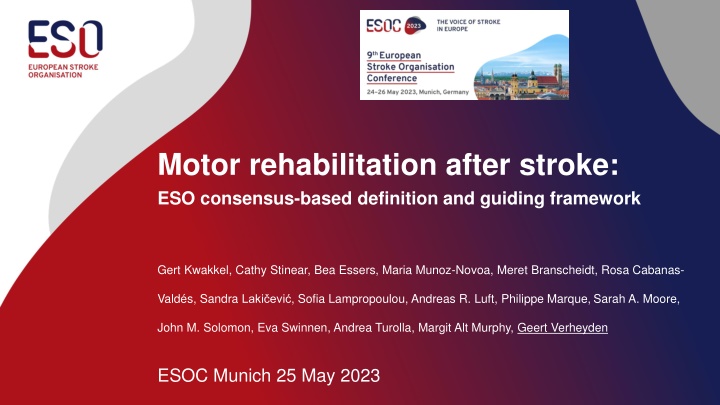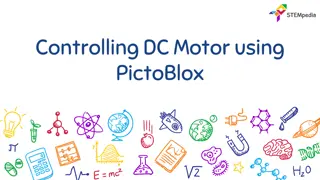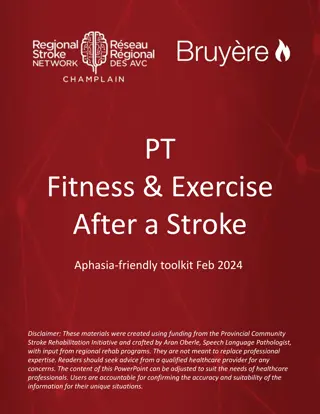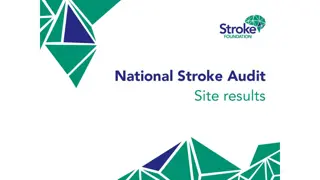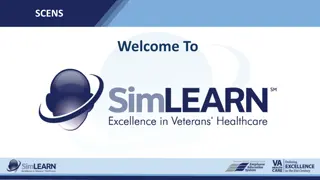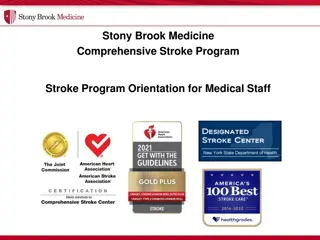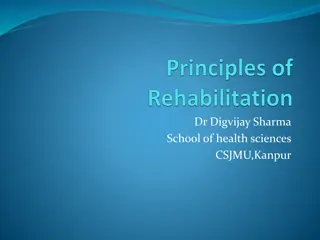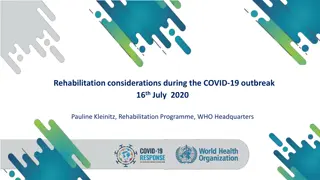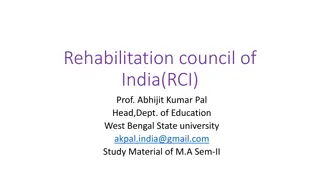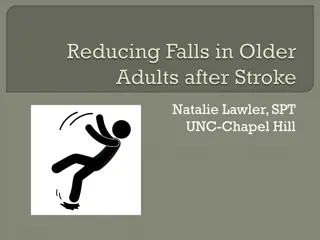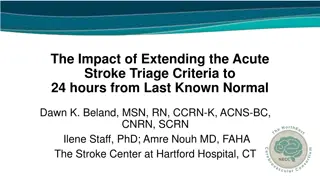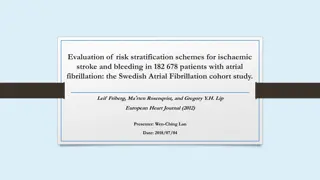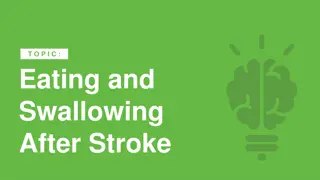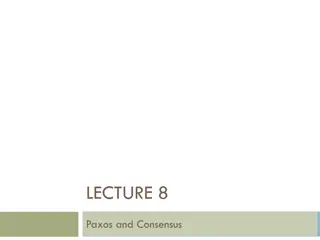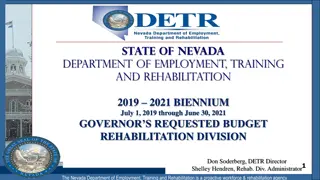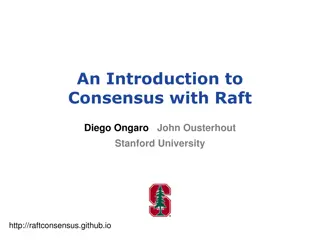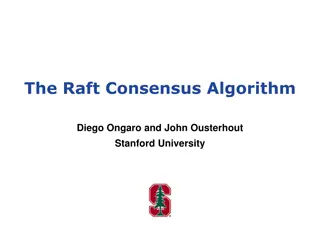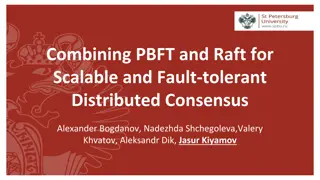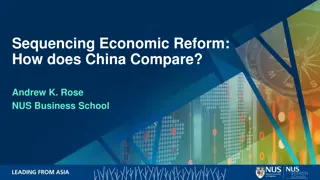Consensus-Based Definition of Motor Rehabilitation after Stroke
Providing an agreed definition of motor rehabilitation post-stroke, this framework synthesizes key literature, offering an overview of the stroke motor rehabilitation domain. Aimed at educators, clinicians, and researchers, it identifies evidence gaps in the field.
Download Presentation

Please find below an Image/Link to download the presentation.
The content on the website is provided AS IS for your information and personal use only. It may not be sold, licensed, or shared on other websites without obtaining consent from the author.If you encounter any issues during the download, it is possible that the publisher has removed the file from their server.
You are allowed to download the files provided on this website for personal or commercial use, subject to the condition that they are used lawfully. All files are the property of their respective owners.
The content on the website is provided AS IS for your information and personal use only. It may not be sold, licensed, or shared on other websites without obtaining consent from the author.
E N D
Presentation Transcript
Motor rehabilitation after stroke: ESO consensus-based definition and guiding framework Gert Kwakkel, Cathy Stinear, Bea Essers, Maria Munoz-Novoa, Meret Branscheidt, Rosa Cabanas- Vald s, Sandra Laki evi , Sofia Lampropoulou, Andreas R. Luft, Philippe Marque,Sarah A. Moore, John M. Solomon, Eva Swinnen, Andrea Turolla, Margit Alt Murphy, Geert Verheyden ESOC Munich 25 May 2023
Disclosures Intellectual Disclosures: None. Financial Disclosures: None. This work received no specific grant from any funding agency in the public, commercial, or not-for-profit sectors.
Module Working Group Members Kwakkel Gert Netherlands Essers Bea Belgium Cabanas-Vald s Rosa Spain Branscheidt Meret Switzerland Verheyden Geert Belgium Alt Murphy Margit Sweden Munoz-Novoa Maria Sweden Lampropoulou Sofia Greece Luft Andreas Switzerland Marque Philippe France Moore Sarah UK Laki evi Sandra Bosnia & Herzegovina Turolla Andrea Italy Solomon John India Stinear Cathy New Zealand Swinnen Eva Belgium
ESO Stroke Action Plan for Europe 30 targets and 72 research priorities within 7 domains One domain targets stroke rehabilitation improving management, outcome and quality of life Rehabilitation defined as a set of measures that assist individuals, who experience or are likely to experience disability, to achieve and maintain optimal functioning in interaction with their environment Specific principles of motor rehabilitation not addressed Norrving et al. Eur Stroke J 2018; WHO 2011
Aim To deliver an agreed definition of motor rehabilitation after stroke Supported by a framework synthesizing key literature to provide a state-of-the-art overview of the stroke motor rehabilitation domain To guide educators, to update clinicians and to enable researchers to identify gaps in the evidence base
Development of the definition Panel of experts (MWG) convened by ESO Guideline Board (n=14) Also, MWG members presented the agreed definition to a convenience sample of clinicians (8 MDs, 33 PTs and 9 OTs) Feedback collated and discussed with final fine-tuning in December 2022 Three-round process Online discussion, first draft and online survey (April-June 2022) Online discussion, revision and second round survey (July-Aug 2022), requiring 75% agreement Online presentation of results, further discussion and fine-tuning (Sep 2022)
ESO consensus-based definition of Motor Rehabilitation after Stroke Motor rehabilitation is a process that engages people with stroke in order to benefit their motor function, activity capacity and performance in daily life. It is necessary for all people with residual motor disability whose goal is to enhance their functioning, independence and participation. Motor rehabilitation strives to reduce motor impairments and improve functioning in activities through learning- and use- dependent mechanisms. The trajectory of motor and functional recovery varies between patients and stages of recovery. At early stages, behavioral restitution of motor function depends on the underlying mechanisms of spontaneous neurological recovery. At later stages, further functional improvements can be achieved by compensations. Motor rehabilitation is guided by regular assessment of motor function and activity using consensus-based measures, including patient-reported outcomes. Results are discussed with the patient and their carers in order to set personal goals. The core element of motor rehabilitation incorporates principles of motor control in which patients learn to optimize and adapt their motor, sensory and cognitive functioning through appropriately dosed, repetitive, goal-oriented, progressive, task- and context-specific training. Motor rehabilitation supports people with stroke to maximise health, well-being and quality of life.
Framework Presenting the ICF as the central concept and contextualising it to motor rehabilitation Summary of the biology of recovery, distinguishing between early versus later recovery Widely recommended motor assessments and prediction tools Summary of strongly recommended evidence-based interventions from recent motor rehabilitation guidelines
Discussion Strengths Expertise of the MWG Considerations Provision of motor rehabilitation differs across the world, but fundamentals of definition are likely similar Definition paragraph consisting of several elements, but motor rehabilitation is multi-faceted A definition that is straightforward for everyone may not cover the specificities sought after by professionals Three-round process Consultation with clinical stakeholders
Conclusion First ESO consensus-based definition of motor rehabilitation after stroke Basis for producing ESO motor rehabilitation guidelines
